Whenever you are, you’ve gone the wrong way. (Via)
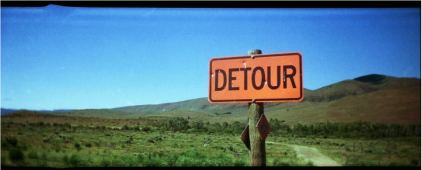
Regina Hackett takes her Art to Go
Whenever you are, you’ve gone the wrong way. (Via)

Caleb Larsen’s Tool to Deceive and Slaughter is on view at Lawrimore Project, but it sold on e-Bay earlier today for $6,350. Auction over? No. This auction will never be over.
Review here. Frquently asked questions below.
- Q: Doesn’t the first sale doctrine prevent you from collecting further payment past the initial sale of the item?
A: In order to be recognized as a work of art the contract must be
adhered to, and regards of who owns it and who buys it the contract
remains between the artist and the purchaser, not between buyer and
seller.
The art world is always saying next, please. I’m bored with your dead tiger shark and live nudes, your singing museum guard and your fallen Pope. The shark that is never dead is the art world itself, which, as Woody Allen explained in Annie Hall, has to keep moving to stay alive.
Those who work in that world shovel the present into the past as a kind of necessary clean-up. For market reasons disguised as aesthetics, key power players determine who among the previously celebrated remains a live wire. The rest will be regulated to the heap of has-beens, to be humiliated and disappeared. Only live wires make the market hum.
Even as they rose like surface to air missiles to art world’s stratospheres, Tim Rollins and K.O.S. lived with an undertow of detractors, those who thought somebody was being exploited here and it could well be them for taking this project seriously.
How could it be taken seriously? The odds against it are impossible.
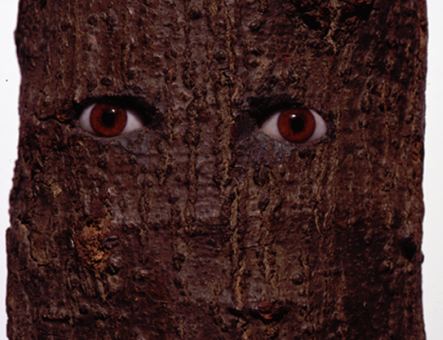 In 1981, when collectors were drinking pink champagne out of glass slippers at the Mary Boone Gallery, a serious student of the Rev. Martin Luther King Jr., John Dewey and Joseph Kosuth stepped off the subway in the South Bronx to the smell of the burning garbage.
In 1981, when collectors were drinking pink champagne out of glass slippers at the Mary Boone Gallery, a serious student of the Rev. Martin Luther King Jr., John Dewey and Joseph Kosuth stepped off the subway in the South Bronx to the smell of the burning garbage.
[Read more…] about Tim Rollins & K.O.S. – courage, vision and durability
Zinn died Wednesday of a heart attack. He was 87. Boston Globe obit here.
If American history is hard to read, it’s because the country’s aspirations fall so far short of its practices. Textbooks tend to respond with cover-ups, but not ones written by Zinn. A People’s History of the United States is a courage teacher. Not only is it scholarly, clear and elegantly written from
original
source materials, its focus is justice: how and when it was denied and
how and when it was achieved. His outrage is accompanied by his
hope, wit and patriotism.
Below, a scene from Deb Ellis and Denis Mueller’s fine documentary titled, Howard Zinn: You Can’t Be Neutral on a Moving Train.
(To purchase, go here.)
.
Unlike the other major members of the Northwest School, Kenneth Callahan did not seek transcendence. What was on earth was good enough for him.
He started out strong as a figurative painter in the 1930s. Forging a
silky yet monumental style, he created men to match Northwest
mountains. He liked muscle-bound grandeur but released the figures who displayed it from the confines of gravity. Full of light, many hover on the edge of floating away.
By the 1940s, he had pinned his figures to the ground with webbing.
There are excellent paintings from this period, but by the late 1960s, he was more interested in abstractions. By the 1970s, his work had taken a brazenly ugly turn, with hot strokes of
orange against blood brown and crinkled masses of shadows.
Bad taste is a fatal flaw in a decorator, but in an artist it’s
neutral. Artists who fully inhabit their bad taste take it to
another realm, where taste is irrelevant. Callahan inhabited his whenever he chose. There were moments in his career when his work was highly prized and edging its way into national prominence, and moments when even in the Northwest he was overlooked. The Northwest School’s Big Four (Morris Graves, Guy Anderson, Mark Tobey and Callahan), evolved into the Big Three, with Callahan missing. If he cared, he did not let on.
A small survey of his career is currently at the Woodside/Braseth Gallery, from the 1940s through the 1980s. (He died in 1986 in his early 80s.) All the best work is missing, but what’s here is swell. The exhibit is light on the abstractions that lost him so many fair-weather friends and concentrates on what everyone admires: his sumi inks, oil portraits of animals and small, florid landscapes.
North Lake Camp, early 1950s, sumi ink. 35 x 46 inches. Imagine that the image the gallery supplied is on white paper in black ink. The sepia tone appears to have arisen from the process of transmittal. At any rate, the fallen cabin on the left belonged to Guy Anderson. Callahan sketched it soon after its demise, when the snow that brought it down had started to clear. The trees moving in and out of focus have a skittery grace. They lean into the light as if they’re starved for it.
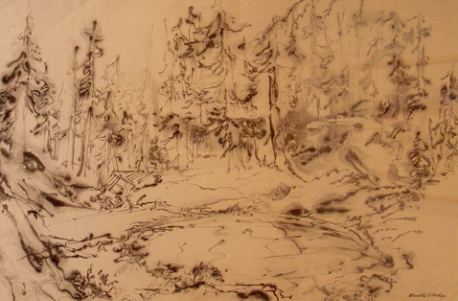
Somewhere between Paint By Numbers and overexposed film negatives are the blue paintings of Joey Veltkamp. Boldly present and barely there, they are illusions floating on soap bubbles and gone.
The series started last year with 1977, below. (The last good kiss you had was years ago.)
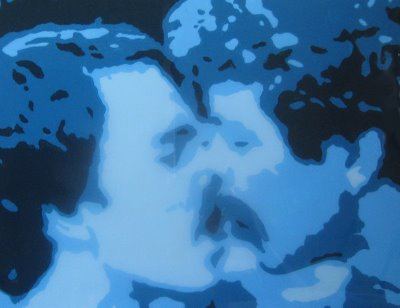 Bear is more recent. It appears to be a self-portrait. (I am the name of my desire.)
Bear is more recent. It appears to be a self-portrait. (I am the name of my desire.)
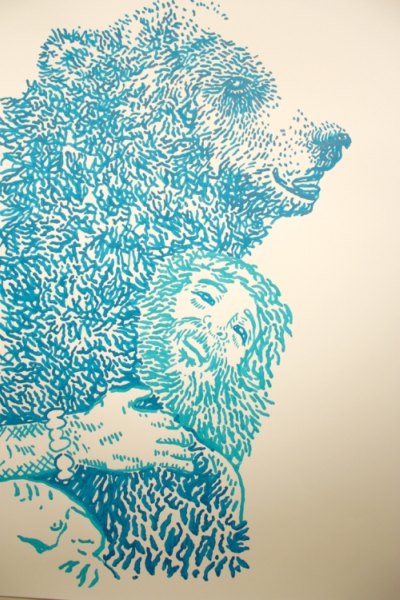 Hunter toys with the stereotype, with what it means to be male.
Hunter toys with the stereotype, with what it means to be male.
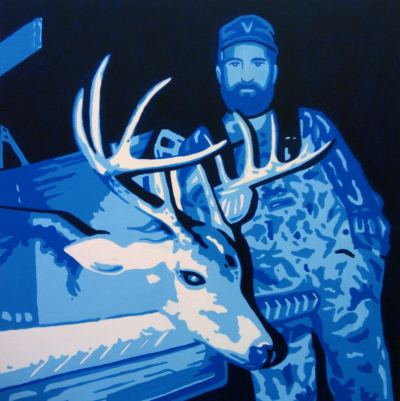 Cowboy celebrates the fun. Note the underwear. This isn’t your grandmother’s cowboy.
Cowboy celebrates the fun. Note the underwear. This isn’t your grandmother’s cowboy.
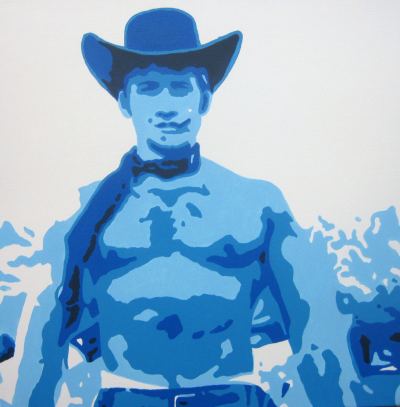 These images and others are on Veltkamp’s flicker stream, here. He also fronts an excellent blog known as Best Of. Before Best Of, Veltkamp was known primarily as an illustrator. In Seattle, he was around but not central.
These images and others are on Veltkamp’s flicker stream, here. He also fronts an excellent blog known as Best Of. Before Best Of, Veltkamp was known primarily as an illustrator. In Seattle, he was around but not central.
The blog allowed him to introduce himself to those who thought they already knew him. With his generosity, wit and ability to engage with the work of other artists, he raised curiosity about what he seldom alludes to – his own work. Partly due to all that engagement, his own work has improved.
Those who bemoan the death of print and the rise of online journalism fail to realize how static print is. Before blogs, somebody like Veltkamp would have had few options to express himself. Newspapers had no room for him. He doesn’t fit their formula. I loved working for a newspaper, but I don’t miss the paper part. Let the trees live.
Nicholas Nyland paints on paper, which he crumbles up or tears into shreds and hangs in garlands. His painted clay looks crumbled too.
 His work can look like nothing at all, tidbits left over from an elementary school art class. What makes it distinctive is time spent. Stand in front of them long enough, and these fragments become wholes. They evoke not rocks on a beach but scholar’s rocks in a studio, each plane and color pattern worthy of attention.
His work can look like nothing at all, tidbits left over from an elementary school art class. What makes it distinctive is time spent. Stand in front of them long enough, and these fragments become wholes. They evoke not rocks on a beach but scholar’s rocks in a studio, each plane and color pattern worthy of attention.
Nyland is in Soil‘s back room through Saturday. In the front gallery is a terrific new members show featuring Iole Alessandrini, Julie Alpert and Ellen Ziegler, also through Saturday.
From the file of up-and-out: Seeking to expand their reach beyond Manhattan, artists send their work to… Seattle.
Outside The Time Zone, the curatorial partnership between Chris Rawson
and Julian Calero, is pleased to announce its first collaborative project outside of New York City. The exhibition is also the inaugural exhibition for Kymata Project Space.
Seattle was chosen as the first host city because the exhibited artists and the curators have intimate connections with the Emerald City and the Northwest.
The four-person exhibition of new work by Chris Burnside, Garek Druss, Ben Needham and Adam Taye is conceived as a meditation on landscape and is inspired by the act of homecoming, travel and displacement, which are themes prevalent in OTZ’s ongoing nomadic curatorial project.
They couldn’t have too many ties in Seattle or they wouldn’t call it the Emerald City. That’s a marketing term, the equivalent of The Big Apple. Those who use it are on the take, out of it or kidding. At any rate, welcome. They open Feb. 11, 6-8 p.m. at 340 15th Ave. E Suite 305.
Chris Burnside, acrylic painted directly on the wall, 2003
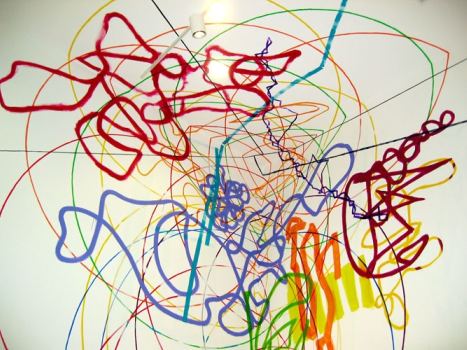
On a personal note: Seattle’s Doug McLennan, founder and publisher of ArtsJournal, interviews an ArtsJournal blogger at Town Hall Tuesday night, 9:15- 10 p.m., free admission. Because I am the only ArtsJournal blogger located in Seattle, that means he’s interviewing me.
To date (and time is running out), the event promises to be free form. We have yet to discuss content, but I’m assuming it relates in some form to arts journalism. Maybe he’ll surprise me and ask about baseball. I could change the topic to fine wine and dining or string theory and still be at sea. Arts journalism it is.
an ArtsJournal blog


